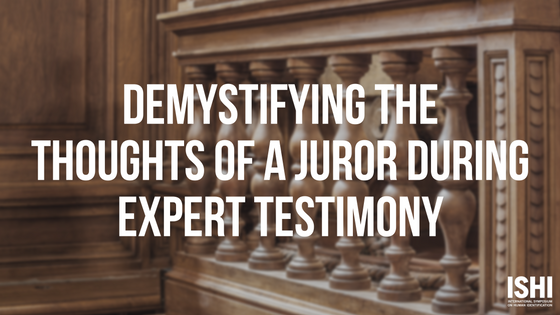As forensic science advances, and its prevalence in courtrooms increases, expert witness testimony has become a critical component to help lay people in the jury understand evidence presented. In this day and age, it’s likely safe to assume that they’ve had some experience with forensic science, and it’s probably also true that this experience has come from a crime drama on TV or in the movies. The extent to which TV dramas inform public opinion is discussed here, but even then, we are still left to wonder – just what is the jury thinking as an expert witness presents forensic identification testimony during a trial?
In the new CBS drama, “Bull”, a team of experts in trial science use psychology, human intuition, and high-tech data to get in the mind of jurors and help their clients win a case. You probably don’t have a team like this at your disposal, but what if you can know what a juror was thinking?
Written by: Tara Luther, Promega
Will a juror assume that witnesses with more experience are more trustworthy than their peers with less experience? Will they favor forensic results that are obtained through more sophisticated technologies? Do they find forensic methods that have been scientifically tested to be more reliable than those that haven’t been tested?
In the past, the answer to those questions was a resounding, “we don’t know”, however these are the very questions that N.J. Schweitzer et al strived to answer in their May 2016 report titled Communicating Forensic Science.
Beyond those questions, the team also wanted to how jurors would view testimony presented by experts who had conceded a possibility of error? Likewise, how would jurors react to experts who claimed to have a high level of confidence, versus those who were less certain?
What if you could know what a juror was thinking while you're presenting expert testimony? Share on X
Constructing the study
To answer these questions, Schweitzer et al conducted a series of controlled studies involving jury simulations- experimental studies where a researcher attempts to reconstruct a jury decision-making environment.
A sample of laypeople were asked to serve as “jurors” in two different cases; the first being a rape case in which the defendant allegedly bit the victim’s shoulder (leaving behind a bitemark), and the second an attempted murder in which fingerprints of the suspect were recovered. Both trials were designed so that the strength of the forensic evidence (the bitemark and fingerprints) would by the key piece of evidence on which the jurors would base their verdicts.
Videos were created to be as close to a real-life trial as possible. Created transcripts were compared to actual trial transcripts and were vetted by attorneys to verify their realism. Upon completion of the transcripts, the videos were filmed in a mock-courtroom at the Arizona State University College of Law, and actors were cast.
Law faculty members with trial litigation experience were cast as attorneys in the video, a forensic science expert was cast as the key witness, and other faculty members and age-appropriate students were cast as judge, victim, and police officer witnesses. In total, 32 videos were created using different combinations of the case and variables within the expert testimony.
The study involved a pool of 876 in-person jurors who deliberated to reach a verdict. These ‘jurors’ resided in Phoenix, Arizona, and were split into groups of 6-8, which each group being shown 1 of the 32 videos.
During the video, jurors were allowed to take written notes on the case (as permitted by the Arizona courts). After the video, each juror was asked to fill out a preliminary questionnaire to measure their initial impression of the case. Once the questionnaires were completed, a jury verdict sheet was provided to the group with instructions for them to deliberate and reach a unanimous verdict.
After a verdict was reached, a second questionnaire was administered that again measured each juror’s perception of the case as well as various attitude measures about science and personal demographic information. Using these two questionnaires, Schweitzer et al were able to determine how the deliberation process had impacted the jurors’ understanding and impressions of the forensic expert testimony.
You may also like:
So, what were they thinking?
Based on these tests, Schweitzer et al found that jurors’ opinions of the forensic evidence presented is most heavily swayed by the expert’s experience level. Other factors, such as whether the evidence was obtained by high or low tech means, or whether or not the methods used had been scientifically validated only minimally impacted the views of the jury. It’s important to note, however, that while the expert’s experience level effected opinions on the evidence presented, it did not impact the final verdict.
The research also showed that the verbiage used by an expert greatly swayed how the evidence was perceived. When an expert stated the defendant was definitely the source of the evidence, jurors returned a guilty verdict three times more frequently than when an expert stated that the evidence was consistent with the defendant.
Interestingly, the type of evidence presented played a large role in whether they viewed evidence favorably. When the case involved bitemark evidence, and the expert conceded that (generally speaking) forensic identifications may be made in error, jurors had less confidence in the evidence. When the case involved fingerprint examination, however, the error concession strengthened the evidence in the eyes of the jury. Schweitzer et al concluded that it is necessary to test multiple forms of forensic evidence for this reason.
So, now you have an idea of what the jury is thinking during an expert’s testimony, but being called upon to testify can be a daunting task no matter how many times you’ve done it. Stay tuned for part two of this series, in which we lay out some actionable tips you can use on the witness stand.
WOULD YOU LIKE TO SEE MORE ARTICLES LIKE THIS? SUBSCRIBE TO THE ISHI BLOG BELOW!


